2009 FORD SUPER DUTY parking brake
[x] Cancel search: parking brakePage 11 of 103
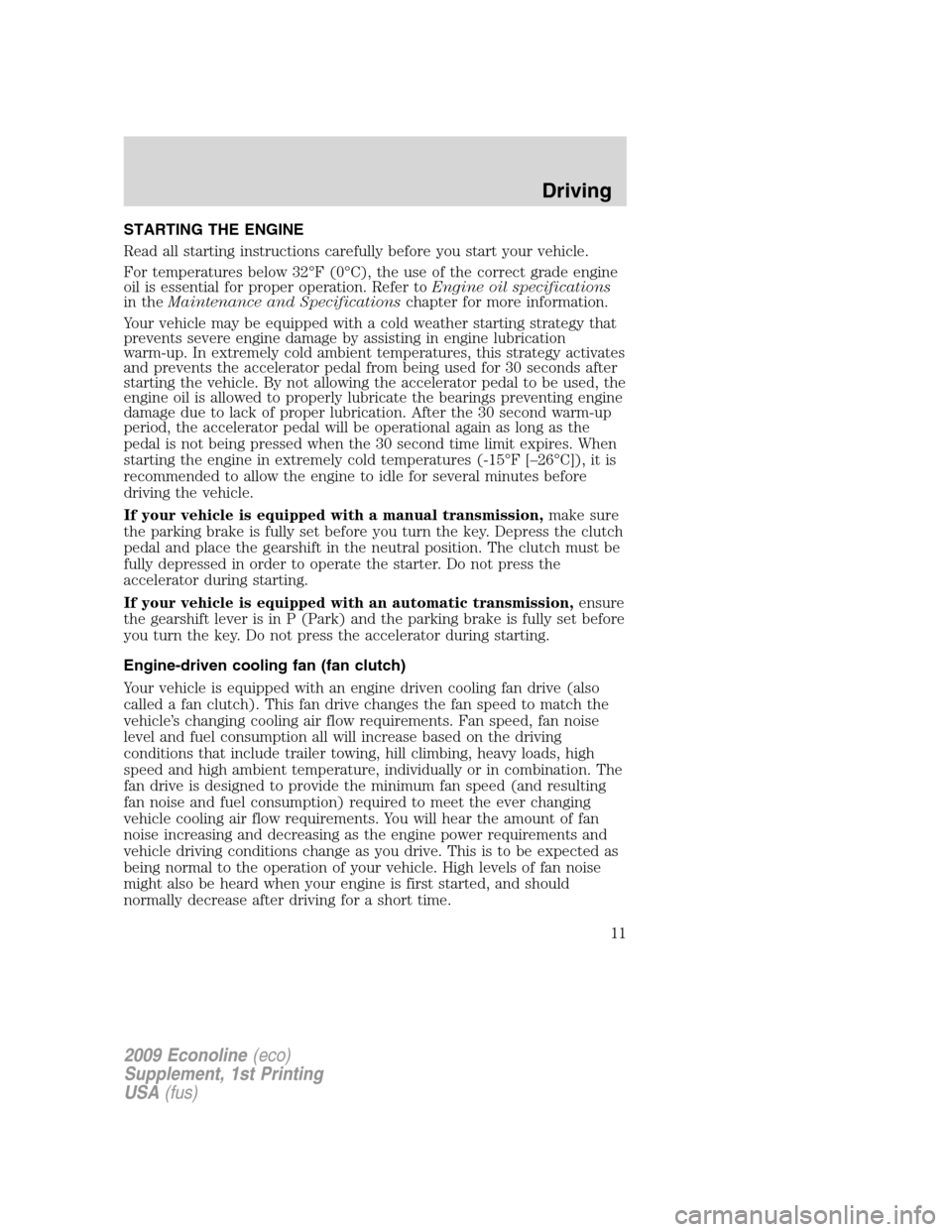
STARTING THE ENGINE
Read all starting instructions carefully before you start your vehicle.
For temperatures below 32°F (0°C), the use of the correct grade engine
oil is essential for proper operation. Refer toEngine oil specifications
in theMaintenance and Specificationschapter for more information.
Your vehicle may be equipped with a cold weather starting strategy that
prevents severe engine damage by assisting in engine lubrication
warm-up. In extremely cold ambient temperatures, this strategy activates
and prevents the accelerator pedal from being used for 30 seconds after
starting the vehicle. By not allowing the accelerator pedal to be used, the
engine oil is allowed to properly lubricate the bearings preventing engine
damage due to lack of proper lubrication. After the 30 second warm-up
period, the accelerator pedal will be operational again as long as the
pedal is not being pressed when the 30 second time limit expires. When
starting the engine in extremely cold temperatures (-15°F [–26°C]), it is
recommended to allow the engine to idle for several minutes before
driving the vehicle.
If your vehicle is equipped with a manual transmission,make sure
the parking brake is fully set before you turn the key. Depress the clutch
pedal and place the gearshift in the neutral position. The clutch must be
fully depressed in order to operate the starter. Do not press the
accelerator during starting.
If your vehicle is equipped with an automatic transmission,ensure
the gearshift lever is in P (Park) and the parking brake is fully set before
you turn the key. Do not press the accelerator during starting.
Engine-driven cooling fan (fan clutch)
Your vehicle is equipped with an engine driven cooling fan drive (also
called a fan clutch). This fan drive changes the fan speed to match the
vehicle’s changing cooling air flow requirements. Fan speed, fan noise
level and fuel consumption all will increase based on the driving
conditions that include trailer towing, hill climbing, heavy loads, high
speed and high ambient temperature, individually or in combination. The
fan drive is designed to provide the minimum fan speed (and resulting
fan noise and fuel consumption) required to meet the ever changing
vehicle cooling air flow requirements. You will hear the amount of fan
noise increasing and decreasing as the engine power requirements and
vehicle driving conditions change as you drive. This is to be expected as
being normal to the operation of your vehicle. High levels of fan noise
might also be heard when your engine is first started, and should
normally decrease after driving for a short time.
2009 Econoline(eco)
Supplement, 1st Printing
USA(fus)
Driving
11
Page 12 of 103
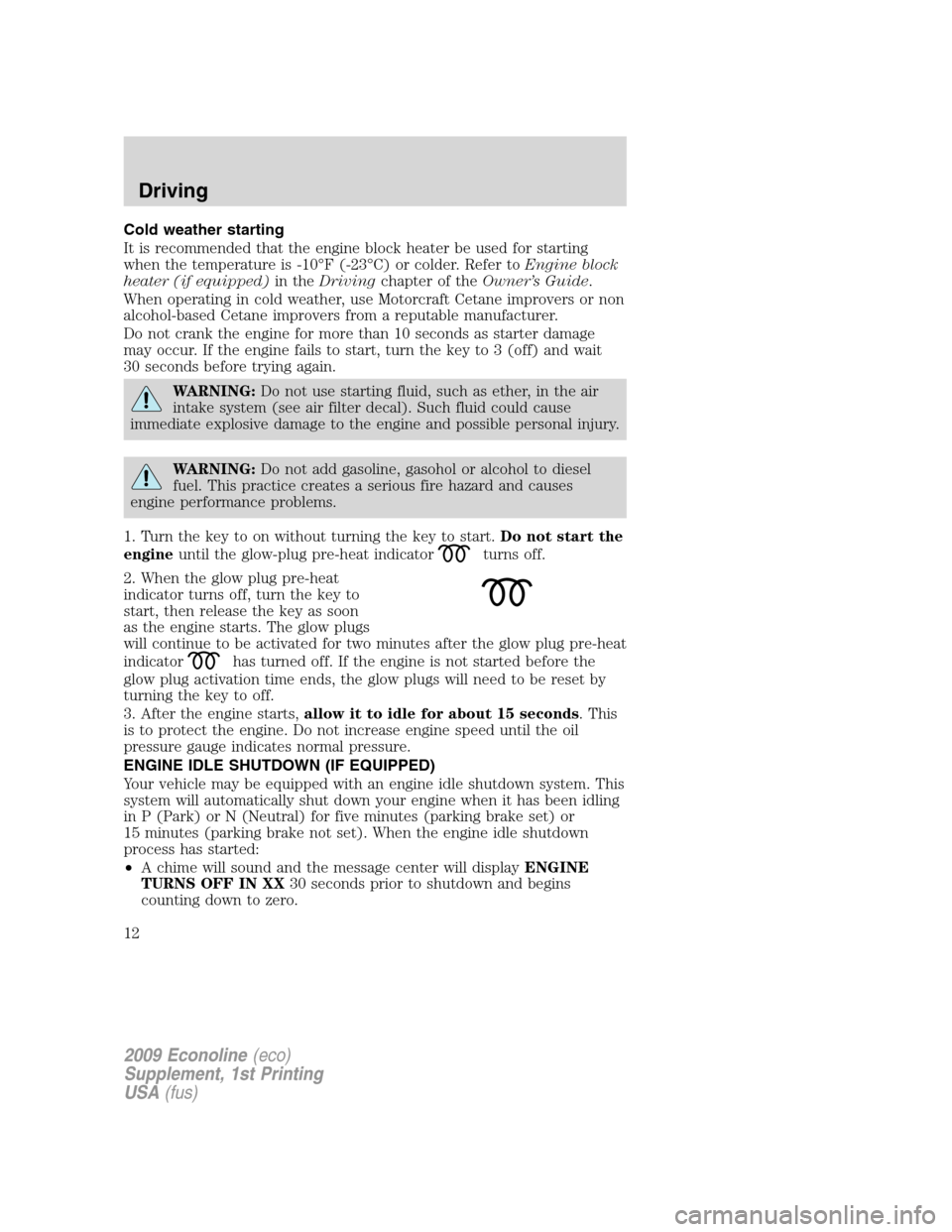
Cold weather starting
It is recommended that the engine block heater be used for starting
when the temperature is -10°F (-23°C) or colder. Refer toEngine block
heater (if equipped)in theDrivingchapter of theOwner’s Guide.
When operating in cold weather, use Motorcraft Cetane improvers or non
alcohol-based Cetane improvers from a reputable manufacturer.
Do not crank the engine for more than 10 seconds as starter damage
may occur. If the engine fails to start, turn the key to 3 (off) and wait
30 seconds before trying again.
WARNING:Do not use starting fluid, such as ether, in the air
intake system (see air filter decal). Such fluid could cause
immediate explosive damage to the engine and possible personal injury.
WARNING:Do not add gasoline, gasohol or alcohol to diesel
fuel. This practice creates a serious fire hazard and causes
engine performance problems.
1. Turn the key to on without turning the key to start.Do not start the
engineuntil the glow-plug pre-heat indicator
turns off.
2. When the glow plug pre-heat
indicator turns off, turn the key to
start, then release the key as soon
as the engine starts. The glow plugs
will continue to be activated for two minutes after the glow plug pre-heat
indicator
has turned off. If the engine is not started before the
glow plug activation time ends, the glow plugs will need to be reset by
turning the key to off.
3. After the engine starts,allow it to idle for about 15 seconds. This
is to protect the engine. Do not increase engine speed until the oil
pressure gauge indicates normal pressure.
ENGINE IDLE SHUTDOWN (IF EQUIPPED)
Your vehicle may be equipped with an engine idle shutdown system. This
system will automatically shut down your engine when it has been idling
in P (Park) or N (Neutral) for five minutes (parking brake set) or
15 minutes (parking brake not set). When the engine idle shutdown
process has started:
•A chime will sound and the message center will displayENGINE
TURNS OFF IN XX30 seconds prior to shutdown and begins
counting down to zero.
2009 Econoline(eco)
Supplement, 1st Printing
USA(fus)
Driving
12
Page 15 of 103
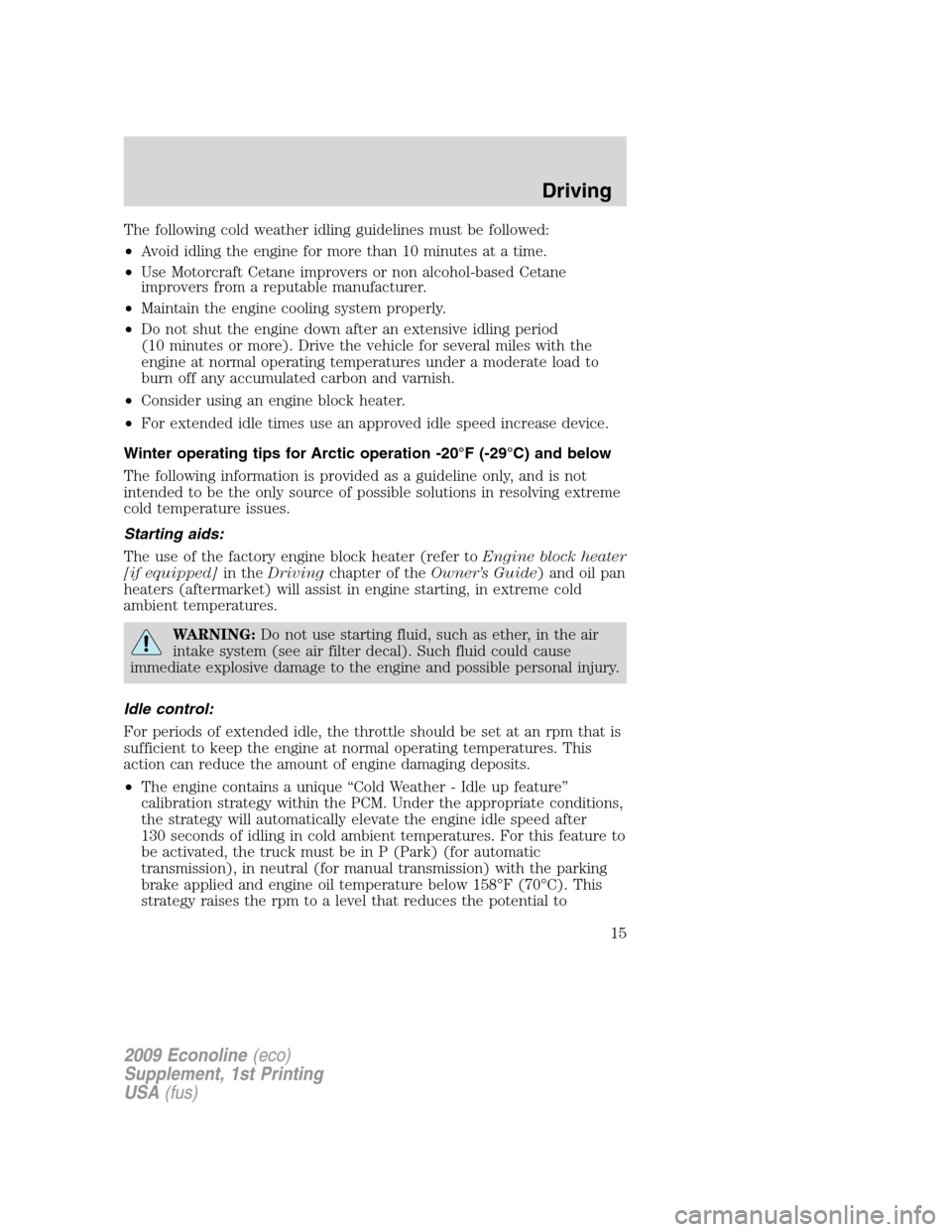
The following cold weather idling guidelines must be followed:
•Avoid idling the engine for more than 10 minutes at a time.
•Use Motorcraft Cetane improvers or non alcohol-based Cetane
improvers from a reputable manufacturer.
•Maintain the engine cooling system properly.
•Do not shut the engine down after an extensive idling period
(10 minutes or more). Drive the vehicle for several miles with the
engine at normal operating temperatures under a moderate load to
burn off any accumulated carbon and varnish.
•Consider using an engine block heater.
•For extended idle times use an approved idle speed increase device.
Winter operating tips for Arctic operation -20°F (-29°C) and below
The following information is provided as a guideline only, and is not
intended to be the only source of possible solutions in resolving extreme
cold temperature issues.
Starting aids:
The use of the factory engine block heater (refer toEngine block heater
[if equipped]in theDrivingchapter of theOwner’s Guide) and oil pan
heaters (aftermarket) will assist in engine starting, in extreme cold
ambient temperatures.
WARNING:Do not use starting fluid, such as ether, in the air
intake system (see air filter decal). Such fluid could cause
immediate explosive damage to the engine and possible personal injury.
Idle control:
For periods of extended idle, the throttle should be set at an rpm that is
sufficient to keep the engine at normal operating temperatures. This
action can reduce the amount of engine damaging deposits.
•The engine contains a unique “Cold Weather - Idle up feature”
calibration strategy within the PCM. Under the appropriate conditions,
the strategy will automatically elevate the engine idle speed after
130 seconds of idling in cold ambient temperatures. For this feature to
be activated, the truck must be in P (Park) (for automatic
transmission), in neutral (for manual transmission) with the parking
brake applied and engine oil temperature below 158°F (70°C). This
strategy raises the rpm to a level that reduces the potential to
2009 Econoline(eco)
Supplement, 1st Printing
USA(fus)
Driving
15
Page 23 of 103
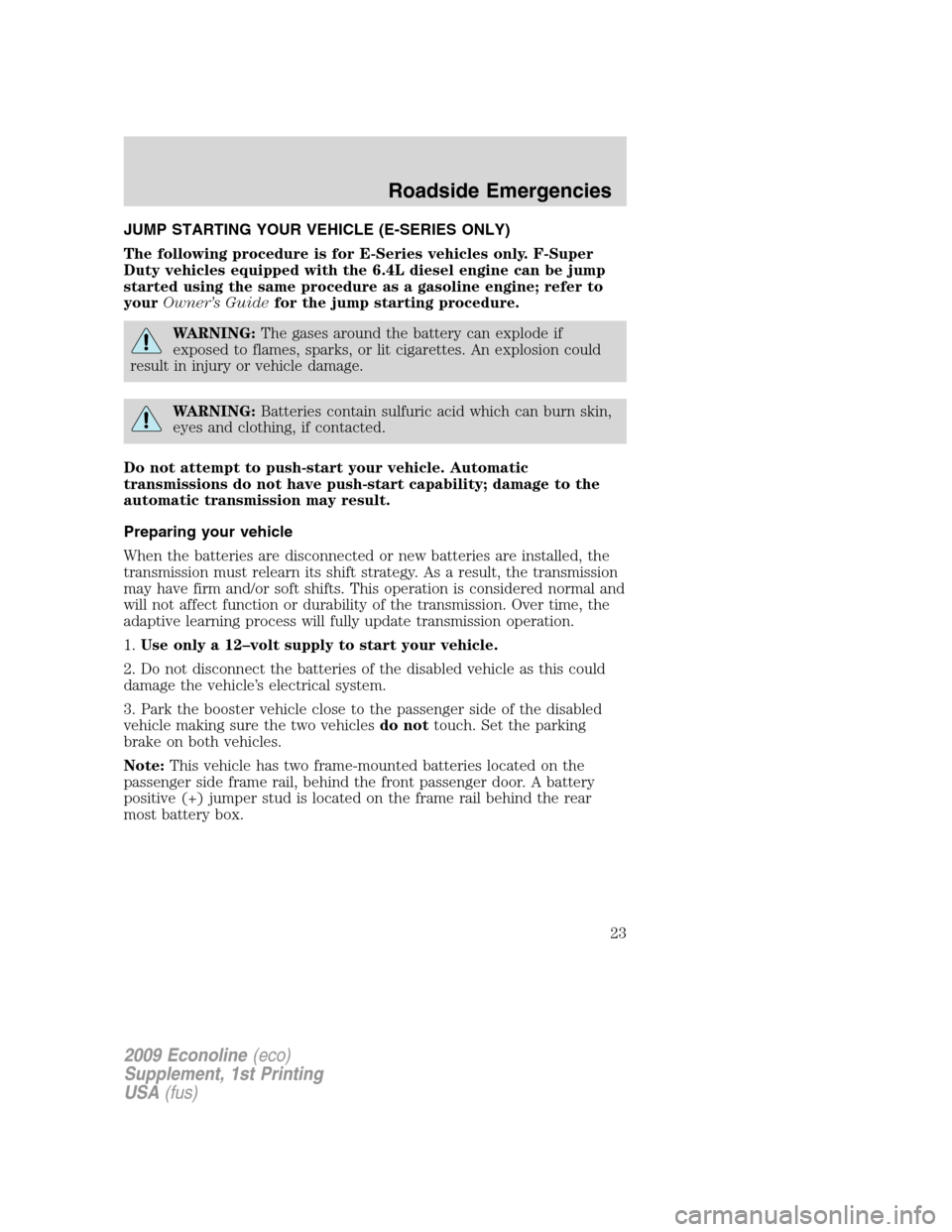
JUMP STARTING YOUR VEHICLE (E-SERIES ONLY)
The following procedure is for E-Series vehicles only. F-Super
Duty vehicles equipped with the 6.4L diesel engine can be jump
started using the same procedure as a gasoline engine; refer to
yourOwner’s Guidefor the jump starting procedure.
WARNING:The gases around the battery can explode if
exposed to flames, sparks, or lit cigarettes. An explosion could
result in injury or vehicle damage.
WARNING:Batteries contain sulfuric acid which can burn skin,
eyes and clothing, if contacted.
Do not attempt to push-start your vehicle. Automatic
transmissions do not have push-start capability; damage to the
automatic transmission may result.
Preparing your vehicle
When the batteries are disconnected or new batteries are installed, the
transmission must relearn its shift strategy. As a result, the transmission
may have firm and/or soft shifts. This operation is considered normal and
will not affect function or durability of the transmission. Over time, the
adaptive learning process will fully update transmission operation.
1.Use only a 12–volt supply to start your vehicle.
2. Do not disconnect the batteries of the disabled vehicle as this could
damage the vehicle’s electrical system.
3. Park the booster vehicle close to the passenger side of the disabled
vehicle making sure the two vehiclesdo nottouch. Set the parking
brake on both vehicles.
Note:This vehicle has two frame-mounted batteries located on the
passenger side frame rail, behind the front passenger door. A battery
positive (+) jumper stud is located on the frame rail behind the rear
most battery box.
2009 Econoline(eco)
Supplement, 1st Printing
USA(fus)
Roadside Emergencies
23
Page 64 of 103
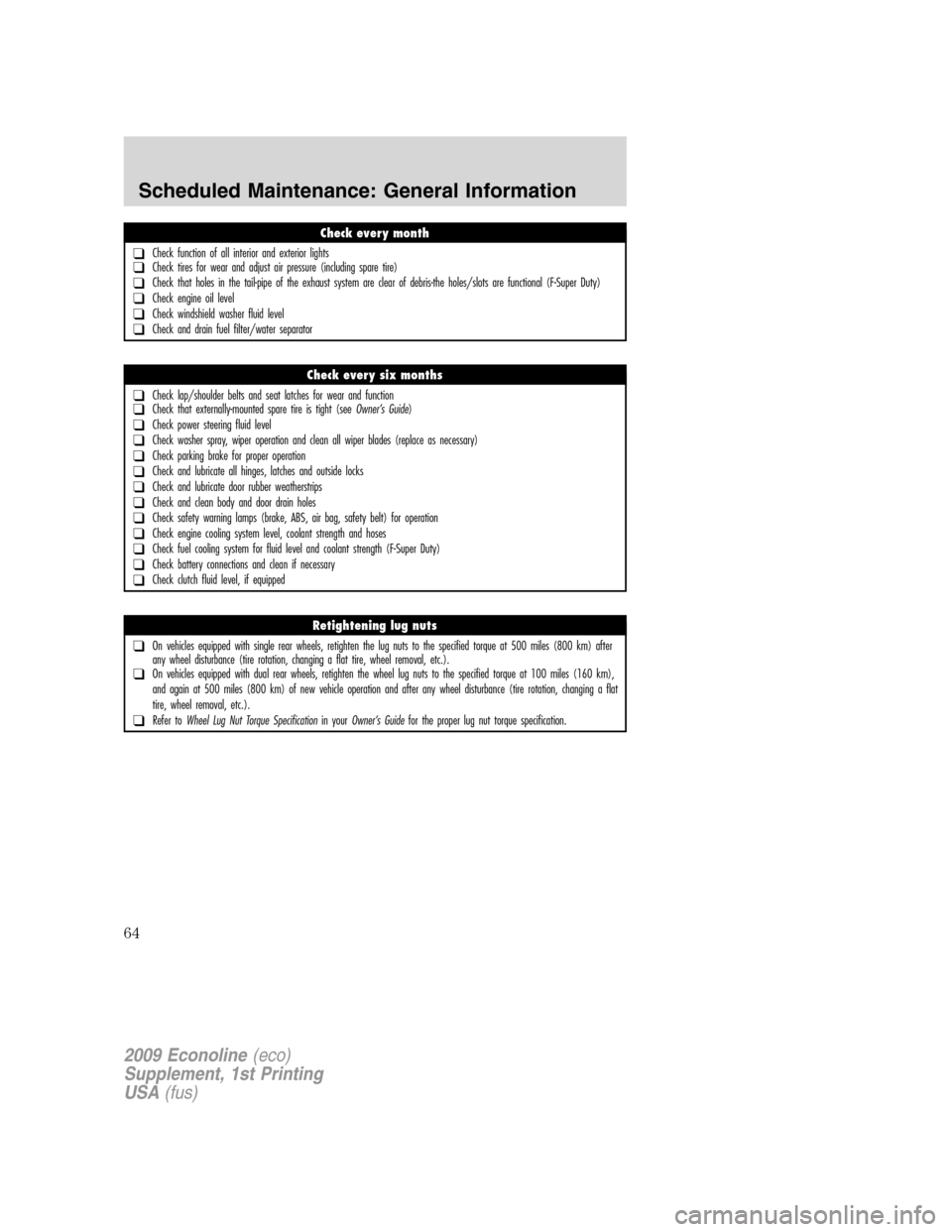
Check every month
❑Check function of all interior and exterior lights❑Check tires for wear and adjust air pressure (including spare tire)
❑Check that holes in the tail-pipe of the exhaust system are clear of debris-the holes/slots are functional (F-Super Duty)
❑Check engine oil level
❑Check windshield washer fluid level
❑Check and drain fuel filter/water separator
Check every six months
❑Check lap/shoulder belts and seat latches for wear and function❑Check that externally-mounted spare tire is tight (seeOwner’s Guide)
❑Check power steering fluid level
❑Check washer spray, wiper operation and clean all wiper blades (replace as necessary)
❑Check parking brake for proper operation
❑Check and lubricate all hinges, latches and outside locks
❑Check and lubricate door rubber weatherstrips
❑Check and clean body and door drain holes
❑Check safety warning lamps (brake, ABS, air bag, safety belt) for operation
❑Check engine cooling system level, coolant strength and hoses
❑Check fuel cooling system for fluid level and coolant strength (F-Super Duty)
❑Check battery connections and clean if necessary
❑Check clutch fluid level, if equipped
Retightening lug nuts
❑On vehicles equipped with single rear wheels, retighten the lug nuts to the specified torque at 500 miles (800 km) after
any wheel disturbance (tire rotation, changing a flat tire, wheel removal, etc.).
❑On vehicles equipped with dual rear wheels, retighten the wheel lug nuts to the specified torque at 100 miles (160 km),
and again at 500 miles (800 km) of new vehicle operation and after any wheel disturbance (tire rotation, changing a flat
tire, wheel removal, etc.).
❑Refer toWheel Lug Nut Torque Specificationin yourOwner’s Guidefor the proper lug nut torque specification.
2009 Econoline(eco)
Supplement, 1st Printing
USA(fus)
Scheduled Maintenance: General Information
64
Page 66 of 103
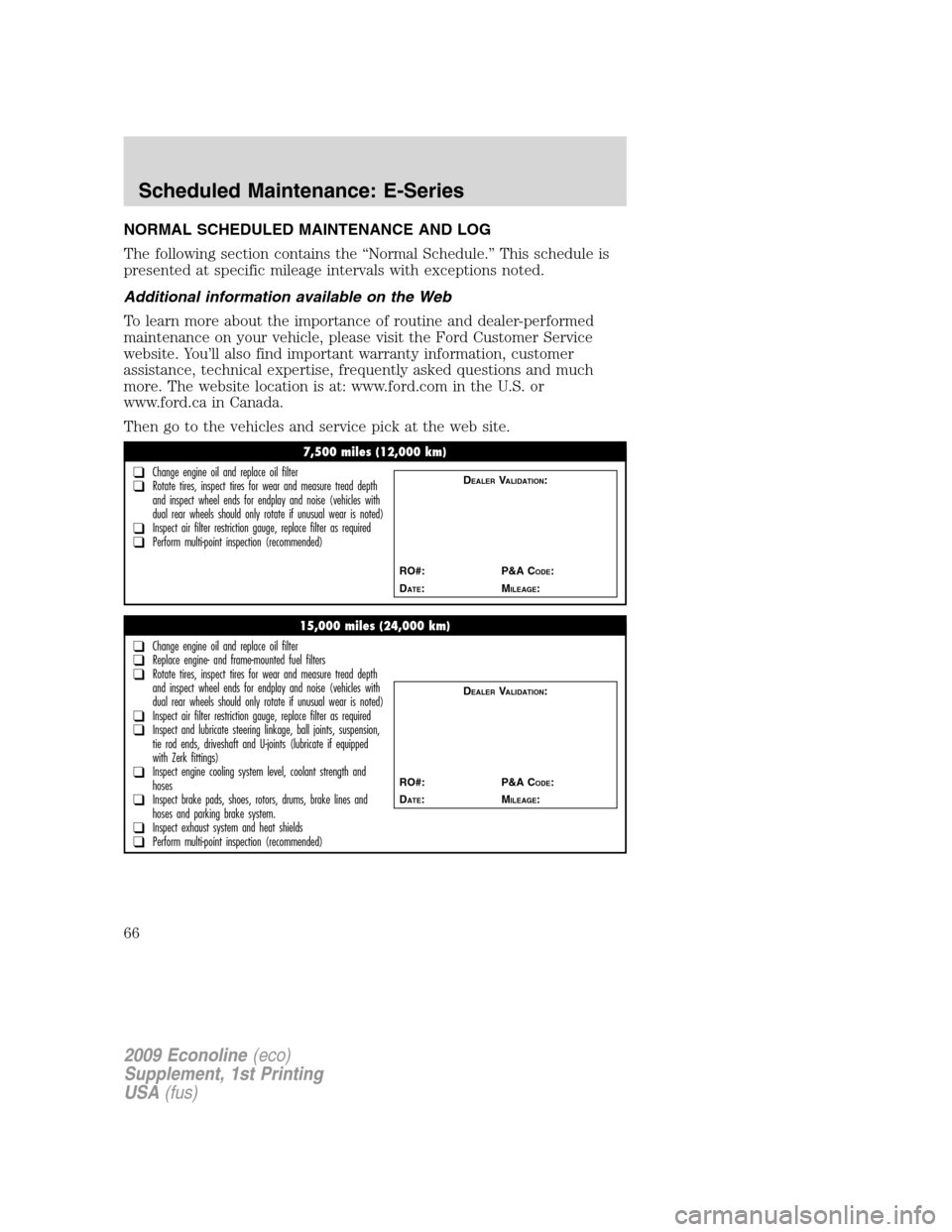
NORMAL SCHEDULED MAINTENANCE AND LOG
The following section contains the “Normal Schedule.” This schedule is
presented at specific mileage intervals with exceptions noted.
Additional information available on the Web
To learn more about the importance of routine and dealer-performed
maintenance on your vehicle, please visit the Ford Customer Service
website. You’ll also find important warranty information, customer
assistance, technical expertise, frequently asked questions and much
more. The website location is at: www.ford.com in the U.S. or
www.ford.ca in Canada.
Then go to the vehicles and service pick at the web site.
7,500 miles (12,000 km)
❑Change engine oil and replace oil filter❑Rotate tires, inspect tires for wear and measure tread depth
and inspect wheel ends for endplay and noise (vehicles with
dual rear wheels should only rotate if unusual wear is noted)
❑Inspect air filter restriction gauge, replace filter as required❑Perform multi-point inspection (recommended)
DEALERVALIDATION:
RO#: P&A C
ODE:
D
ATE:MILEAGE:
15,000 miles (24,000 km)
❑Change engine oil and replace oil filter❑Replace engine- and frame-mounted fuel filters❑Rotate tires, inspect tires for wear and measure tread depth
and inspect wheel ends for endplay and noise (vehicles with
dual rear wheels should only rotate if unusual wear is noted)
❑Inspect air filter restriction gauge, replace filter as required❑Inspect and lubricate steering linkage, ball joints, suspension,
tie rod ends, driveshaft and U-joints (lubricate if equipped
with Zerk fittings)
❑Inspect engine cooling system level, coolant strength and
hoses
❑Inspect brake pads, shoes, rotors, drums, brake lines and
hoses and parking brake system.
❑Inspect exhaust system and heat shields❑Perform multi-point inspection (recommended)
DEALERVALIDATION:
RO#: P&A C
ODE:
D
ATE:MILEAGE:
2009 Econoline(eco)
Supplement, 1st Printing
USA(fus)
Scheduled Maintenance: E-Series
66
Page 67 of 103
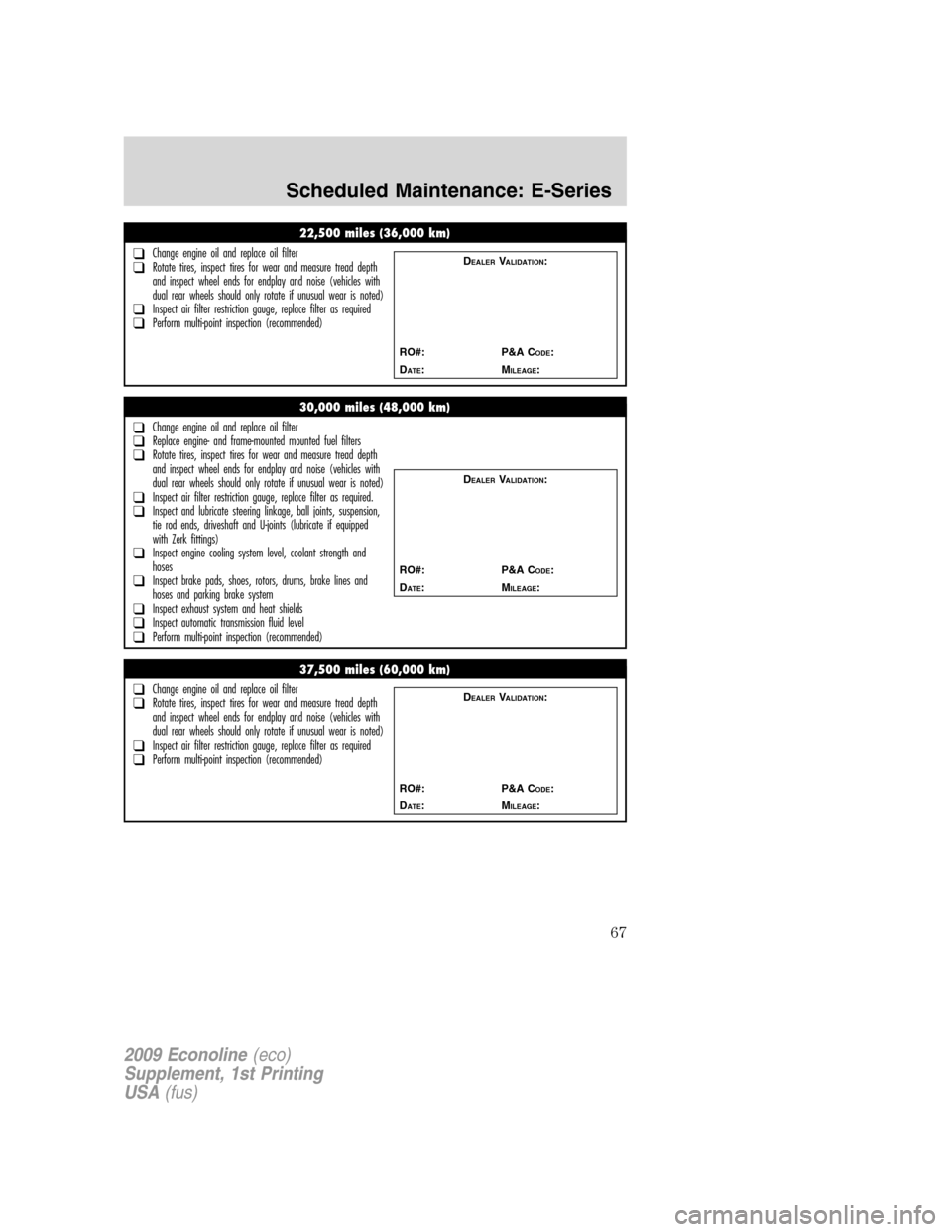
22,500 miles (36,000 km)
❑Change engine oil and replace oil filter❑Rotate tires, inspect tires for wear and measure tread depth
and inspect wheel ends for endplay and noise (vehicles with
dual rear wheels should only rotate if unusual wear is noted)
❑Inspect air filter restriction gauge, replace filter as required❑Perform multi-point inspection (recommended)
DEALERVALIDATION:
RO#: P&A C
ODE:
D
ATE:MILEAGE:
30,000 miles (48,000 km)
❑Change engine oil and replace oil filter❑Replace engine- and frame-mounted mounted fuel filters❑Rotate tires, inspect tires for wear and measure tread depth
and inspect wheel ends for endplay and noise (vehicles with
dual rear wheels should only rotate if unusual wear is noted)
❑Inspect air filter restriction gauge, replace filter as required.❑Inspect and lubricate steering linkage, ball joints, suspension,
tie rod ends, driveshaft and U-joints (lubricate if equipped
with Zerk fittings)
❑Inspect engine cooling system level, coolant strength and
hoses
❑Inspect brake pads, shoes, rotors, drums, brake lines and
hoses and parking brake system
❑Inspect exhaust system and heat shields❑Inspect automatic transmission fluid level❑Perform multi-point inspection (recommended)
DEALERVALIDATION:
RO#: P&A C
ODE:
D
ATE:MILEAGE:
37,500 miles (60,000 km)
❑Change engine oil and replace oil filter❑Rotate tires, inspect tires for wear and measure tread depth
and inspect wheel ends for endplay and noise (vehicles with
dual rear wheels should only rotate if unusual wear is noted)
❑Inspect air filter restriction gauge, replace filter as required❑Perform multi-point inspection (recommended)
DEALERVALIDATION:
RO#: P&A C
ODE:
D
ATE:MILEAGE:
2009 Econoline(eco)
Supplement, 1st Printing
USA(fus)
Scheduled Maintenance: E-Series
67
Page 68 of 103
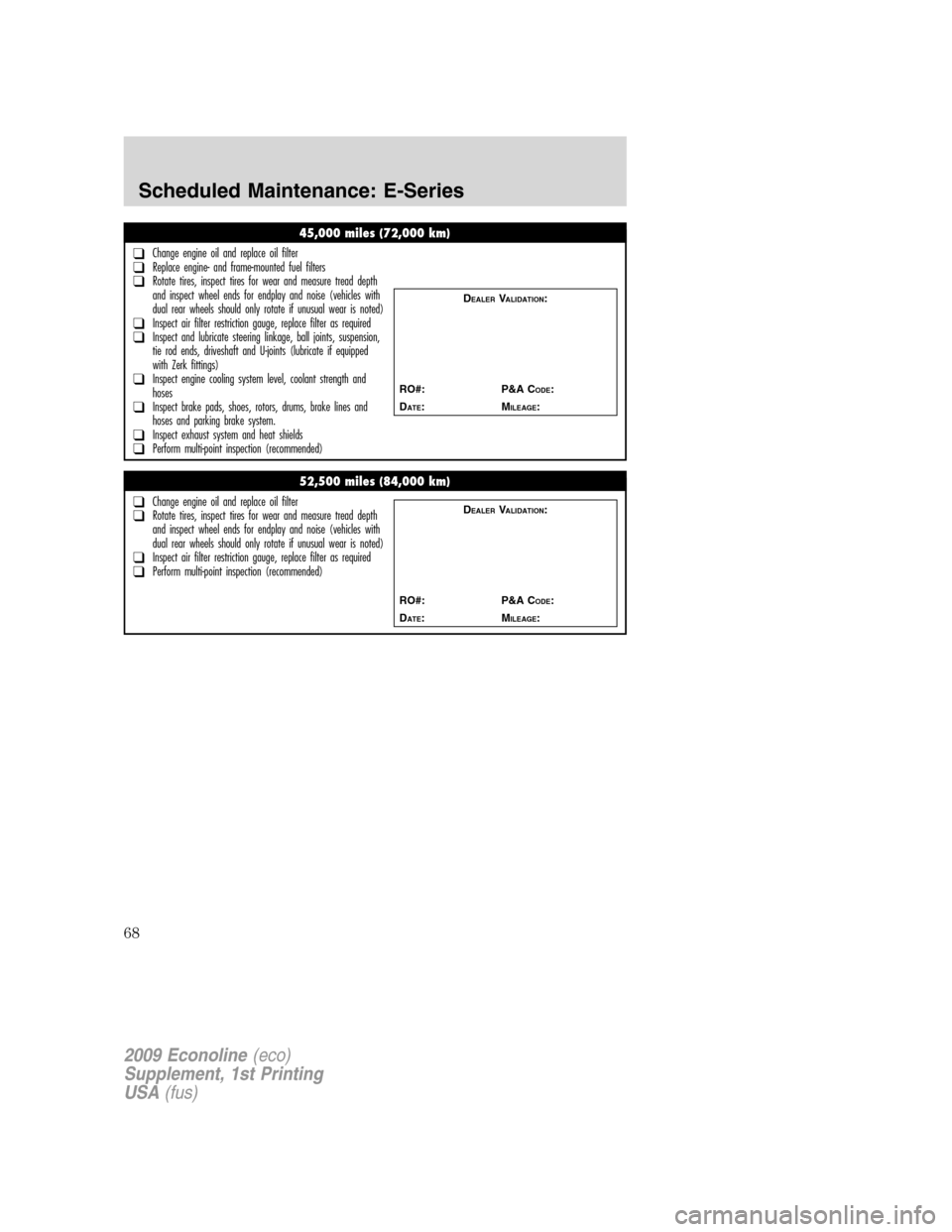
45,000 miles (72,000 km)
❑Change engine oil and replace oil filter❑Replace engine- and frame-mounted fuel filters❑Rotate tires, inspect tires for wear and measure tread depth
and inspect wheel ends for endplay and noise (vehicles with
dual rear wheels should only rotate if unusual wear is noted)
❑Inspect air filter restriction gauge, replace filter as required❑Inspect and lubricate steering linkage, ball joints, suspension,
tie rod ends, driveshaft and U-joints (lubricate if equipped
with Zerk fittings)
❑Inspect engine cooling system level, coolant strength and
hoses
❑Inspect brake pads, shoes, rotors, drums, brake lines and
hoses and parking brake system.
❑Inspect exhaust system and heat shields❑Perform multi-point inspection (recommended)
DEALERVALIDATION:
RO#: P&A C
ODE:
D
ATE:MILEAGE:
52,500 miles (84,000 km)
❑Change engine oil and replace oil filter❑Rotate tires, inspect tires for wear and measure tread depth
and inspect wheel ends for endplay and noise (vehicles with
dual rear wheels should only rotate if unusual wear is noted)
❑Inspect air filter restriction gauge, replace filter as required❑Perform multi-point inspection (recommended)
DEALERVALIDATION:
RO#: P&A C
ODE:
D
ATE:MILEAGE:
2009 Econoline(eco)
Supplement, 1st Printing
USA(fus)
Scheduled Maintenance: E-Series
68